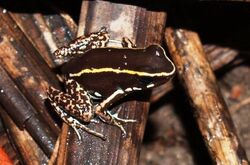| Lovely poison dart frog | |
|---|---|
 | |
| Physical description | |
| Binomial name | Phyllobates lugubris |
| Habitat | Tropical rainforest |
| Lifespan | 6-15+ years |
| Average Size | 2.5 cm (1.0 in) |
| Average weight | 2 grams |
| Diet | Insectivorous |
| Conservational Status | |
| Status | Near threatened |
| IUCN status | 3.1 |
| Scientific classification | |
| Phylum | Chordata |
| Class | Amphibia |
| Order | Anura |
| Family | Dendrobatidae |
| Genus | Phyllobates |
| Species | P. lugubris |
| Distribution | |
| Distribution of species | Honduras |
The lovely poison dart frog, Phyllobates vittatus, is a species of poison dart frog. It is endemic to Honduras. The lovely poison dart frog is the smallest and least-toxic of the Phyllobates genus and is one of the northernmost poison dart frogs.
Poison
The lovely poison dart frog is the least toxic of the lethal Phyllobates species. Its skin secretes pumiliotoxin A, the most toxic of the three pumiliotoxin types. Pumiliotoxin A, like other pumiliotoxins, functions by blocking muscle contractions, which can cause cardiac arrest and respiratory failure. P. lugubris contains a surprisingly high amount of pumiliotoxin for a frog of its size; thus touching a wild specimen can have serious and possibly life-threatening consequences.
Pumiliotoxin is deadly in high concentrations. Pumiliotoxin is weaker than allopumiliotoxin and especially batrachotoxin, with a lethal dose of 2 mg (P. lugubris carries about three-quarters of a milligram). There are three different types of this toxin A, B and C. Toxins A and B are significantly more toxic than C. Pumiliotoxins affect the body because they interfere with muscle contraction in the heart and skeletal muscle. The toxin works by affecting the calcium channels. Some of the symptoms of pumiliotoxins are partial paralysis, having difficulty moving, being hyperactive and in some cases it can result in death.